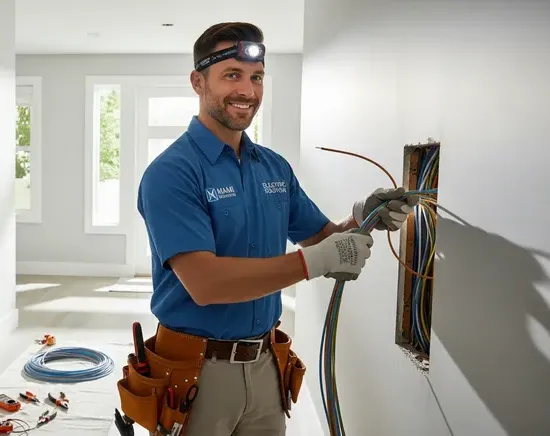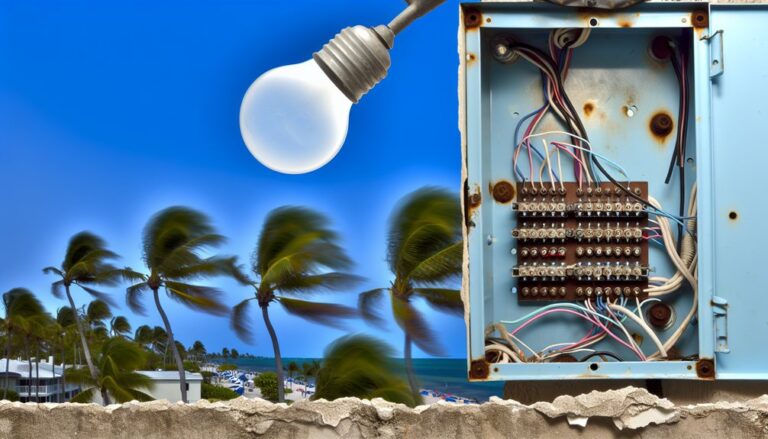Removing Old or Faulty Wiring
Removing old or faulty wiring is essential to maintain safety and efficiency in your electrical system. Deteriorated wiring can lead to serious hazards like electrical fires or system failures. You should look for signs of trouble, such as frequent breaker trips or flickering lights. It’s wise to consult a professional electrician for a thorough inspection and safe removal, ensuring compliance with safety standards. Discover more about the steps involved and the importance of regular inspections for your home’s electrical safety.
Key Takeaways
- Identify outdated wiring types such as knob-and-tube or aluminum, as they pose significant safety risks and require professional removal.
- Consult a qualified electrician to evaluate and safely remove old or faulty wiring, ensuring compliance with safety standards.
- Regular inspections can uncover deteriorating wiring, prompting timely removal to prevent electrical fires or system failures.
- Attempting DIY removal of old wiring can lead to hazards; always trust experts for safe and efficient wiring upgrades.
- Upgrading old wiring not only enhances safety but also improves the efficiency and longevity of the electrical system.

Understanding the Risks of Old Wiring
When you consider the age of your home’s wiring, it’s crucial to recognize the potential hazards that can arise.
Wiring deterioration occurs over time due to various factors, including environmental wear, thermal cycling, and material degradation. As insulation breaks down, it exposes conductive materials, increasing the risk of short circuits and electrical fires.
Additionally, outdated wiring may not handle modern electrical loads, leading to overheating and potential system failures. These safety hazards can compromise not only your home but also your personal safety.
Regular assessments of your wiring system can help identify deterioration before it escalates into a more significant issue. Being proactive can ultimately safeguard your home, preventing costly repairs and ensuring a secure living environment.
Common Signs of Faulty Electrical Systems
Recognizing the signs of a faulty electrical system is essential for maintaining safety in your home. Ignoring these indicators can lead to serious electrical hazards. Here are some common signs you should watch for:
| Sign | Description |
|---|---|
| Frequent Circuit Breaker Trips | This indicates faulty circuits or overloads. |
| Flickering Lights | Often a sign of loose wiring or connections. |
| Burning Smell | A clear indication of overheating components. |
| Discolored Outlets | Suggests potential arcing or faulty circuits. |
If you notice any of these signs, it’s vital to address them immediately. Faulty circuits can not only disrupt your daily life but also pose significant risks to your safety. Don’t delay in seeking professional help.
The Importance of Regular Electrical Inspections
Regular electrical inspections are essential for ensuring the safety and efficiency of your home’s electrical system. By adhering to current electrical codes and safety standards, you minimize the risk of hazards such as electrical fires or system failures.
During an inspection, a qualified electrician evaluates the integrity of wiring, outlets, and circuit breakers, identifying potential issues before they escalate. They also verify compliance with local regulations, ensuring that your system meets necessary safety requirements.
In addition, inspections enhance energy efficiency, potentially reducing your electricity bills. By prioritizing these evaluations, you’re not just protecting your property; you’re safeguarding your family.
Regular checks can ultimately extend the lifespan of your electrical system, providing peace of mind in your daily activities.
How to Identify Outdated Wiring Types
Identifying outdated wiring types is essential for maintaining a safe electrical system. You should familiarize yourself with common outdated wiring materials and their characteristics. Here’s a concise overview:
| Wiring Type | Characteristics | Safety Concerns |
|---|---|---|
| Knob-and-Tube | Insulated with ceramic knobs | Risk of overheating |
| Aluminum Wiring | Lightweight, conductive | Prone to corrosion |
| Plastic-Sheathed | Often used in older homes | May degrade over time |
| Cloth-Bound | Fabric insulation | Vulnerable to fraying |
When you spot these outdated wiring types in your home, it’s vital to consult a professional. Ignoring these wiring materials can lead to serious safety hazards, including electrical fires.
Steps to Safely Remove Old Wiring
Before you begin removing old wiring, it’s essential to guarantee you’ve taken the proper safety precautions.
Start by disconnecting the power supply to the area where you’ll work. Use a multimeter to confirm that no voltage is present. Equip yourself with appropriate safety equipment, including gloves and safety goggles, to protect against potential hazards.
Gather your wiring tools, such as wire cutters, screwdrivers, and pliers, ensuring they’re in good condition. Carefully remove any coverings or fixtures to access the wiring.
Cut the wires close to their source, making sure to avoid damaging any surrounding structures. Dispose of the old wiring properly, following local regulations.
Always keep your workspace organized to minimize risks during the removal process.
Upgrading Your Electrical System: What to Consider
When considering an upgrade to your electrical system, it’s crucial to assess your current needs and future plans.
Start by evaluating energy efficiency and the types of electrical upgrades that will enhance your home’s functionality.
Consider the following factors:
- Load Requirements: Determine the total electrical load your home will need, factoring in future appliances and devices.
- Code Compliance: Verify any upgrades meet local building codes and regulations for safety.
- Sustainability Options: Explore energy-efficient technologies, such as LED lighting and smart home systems, to reduce your carbon footprint.
The Role of Professional Electricians in Wiring Removal
While tackling the removal of old or faulty wiring, it’s vital to rely on professional electricians who possess the expertise and tools necessary for the task.
They conduct thorough wiring inspections to identify potential hazards and understand the specific challenges associated with your electrical system.
Their qualifications, including licensing and experience, make certain that they’re equipped to handle complex wiring removal safely and efficiently.
Attempting this task without professional assistance can lead to serious consequences, such as electrical fires or code violations.
By employing a qualified electrician, you guarantee compliance with safety standards and regulations, ultimately protecting your property and guaranteeing a reliable electrical system.
Trusting experts in this field is essential for a successful wiring removal process.
Cost Factors Involved in Rewiring Your Home
Understanding the cost factors involved in rewiring your home is essential, as several variables can greatly impact your overall expenses.
Key elements influencing rewiring costs include:
- Square Footage: Larger homes typically incur higher installation fees due to the increased material and labor requirements.
- Type of Wiring: Upgrading to higher-quality or specialized wiring can raise costs, affecting both materials and labor.
- Labor Rates: Regional differences in electrician rates can considerably influence your total expenditure.
Tips for Maintaining Your Electrical System
After addressing the cost factors of rewiring, it’s important to focus on how to keep your electrical system in ideal condition.
Regular electrical maintenance is essential to avoid costly repairs and enhance safety. Start by inspecting your circuit breakers and fuses for any signs of wear or damage.
Schedule routine checks for potential overloads and make certain that your outlets are functioning properly. If you notice flickering lights or frequent tripping, it may be time for wiring upgrades.
Keep an eye on the age of your wiring; older systems are more prone to faults.
Finally, maintain clear access to your electrical panel, making sure it’s free from clutter and easily reachable for any necessary upgrades or emergency interventions.
Resources for Homeowners: Ensuring Electrical Safety
To secure electrical safety in your home, it’s crucial to access reliable resources tailored for homeowners. Understanding safety regulations and the need for electrical upgrades can greatly reduce risks.
Here are some key resources you should consider:
- National Electrical Code (NEC): Familiarize yourself with the latest NEC guidelines to guarantee compliance with safety standards.
- Local Building Authorities: Consult these offices for information on permits and inspections related to electrical work in your area.
- Professional Electricians: Engage licensed electricians for assessments, upgrades, and repairs, as their expertise guarantees adherence to safety regulations.
Utilizing these resources can help you maintain a safe electrical environment, minimizing hazards and promoting long-term efficiency in your home’s electrical system.
About Us
We understand that electrical issues can be stressful and overwhelming. That’s why we are here to lend a helping hand and provide you with the best electrical services in town. As a team of experienced electricians, we take pride in our ability to solve any electrical problem with precision and care.
Pages
Follow us
© 2025 By Electrician Fort Lauderdale Today






